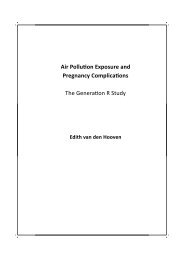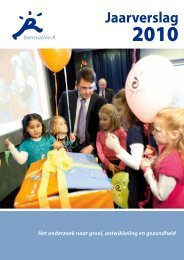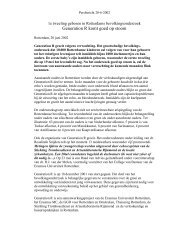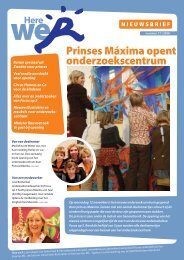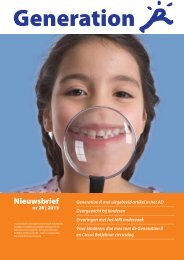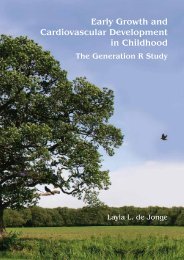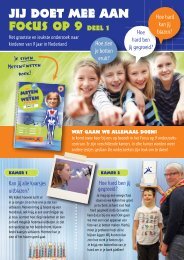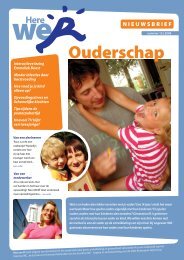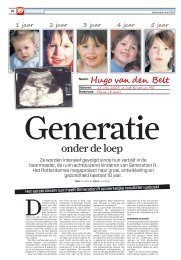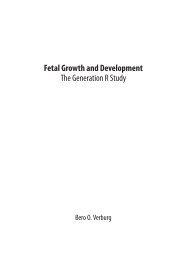Parents and infants: determinants of attachment in a ... - Generation R
Parents and infants: determinants of attachment in a ... - Generation R
Parents and infants: determinants of attachment in a ... - Generation R
You also want an ePaper? Increase the reach of your titles
YUMPU automatically turns print PDFs into web optimized ePapers that Google loves.
Chapter 1<br />
Kranenburg, Van IJzendoorn, Moran, Pederson, & Benoit, 2006). In stressful<br />
situations, disorganized children experience “fright without solution”:<br />
they need the caregiver to help them deal with the stress, but they cannot<br />
approach the caregiver who is also a source <strong>of</strong> fear. In this paradoxical situation,<br />
the <strong>attachment</strong> strategy is thought to collapse (Hesse & Ma<strong>in</strong>, 2006;<br />
Ma<strong>in</strong> & Hesse, 1990).<br />
Environmental factors<br />
Previous studies have identified several environmental factors that are<br />
related to a higher risk <strong>of</strong> <strong>attachment</strong> <strong>in</strong>security <strong>and</strong> disorganization (for<br />
a meta-analysis see Van IJzendoorn, Schuengel, & Bakermans-Kranenburg,<br />
1999). Most <strong>of</strong> these factors, such as circumstances that put caregivers<br />
under stress, for example a low socio-economic status or s<strong>in</strong>gle parenthood,<br />
are thought to affect <strong>attachment</strong> quality because they decrease sensitive<br />
responsiveness <strong>and</strong> <strong>in</strong>crease frighten<strong>in</strong>g behavior <strong>of</strong> the caregiver. There is<br />
some consensus that severe <strong>and</strong> chronic cl<strong>in</strong>ical parental psychopathology<br />
also affects <strong>attachment</strong> related caregiver behavior, for example caregivers<br />
may be less responsive to their children’s needs due to depressive symptoms<br />
such as concentration problems, fatigue, loss <strong>of</strong> <strong>in</strong>terest, negative cognitions<br />
<strong>and</strong> negative affect (Campbell, Brownell, Hungerford, Spieker, Mohan, &<br />
Bless<strong>in</strong>g, 2004; Gelf<strong>and</strong> & Teti, 1990; Mills-Koonce, Gariepy, Sutton & Cox,<br />
2008). Other common symptoms <strong>of</strong> depression such as dissociative periods,<br />
irritability, <strong>and</strong> flattened affect, may be related to <strong>attachment</strong> disorganization<br />
because they can be <strong>in</strong>explicable for a child <strong>and</strong> therefore potentially<br />
frighten<strong>in</strong>g.<br />
Research <strong>in</strong> this area has been ma<strong>in</strong>ly conducted with mother-<strong>in</strong>fant<br />
dyads. Studies concern<strong>in</strong>g sensitive responsiveness <strong>and</strong> <strong>attachment</strong> relationships<br />
<strong>of</strong> fathers are scarce <strong>and</strong> f<strong>in</strong>d<strong>in</strong>gs to date are equivocal. Some<br />
studies failed to f<strong>in</strong>d a significant relation between paternal sensitivity <strong>and</strong><br />
<strong>attachment</strong> security (Braungart-Rieker, Garwood, Powers, & Wang, 2001;<br />
Voll<strong>in</strong>g et al., 2002). Others, however, found that fathers who spent more<br />
time with their <strong><strong>in</strong>fants</strong> had more positive <strong>in</strong>teractions with them <strong>and</strong> that<br />
paternal sensitive behavior was related to <strong>attachment</strong> security (Cox, Owen,<br />
Henderson, & Marg<strong>and</strong>, 1992; Das Eiden, Edwards, & Leonard, 2002).<br />
These studies provide some empirical evidence suggest<strong>in</strong>g that similar<br />
factors are <strong>in</strong>volved <strong>in</strong> <strong>in</strong>fant-father <strong>and</strong> <strong>in</strong>fant-mother <strong>attachment</strong>, but<br />
<strong>in</strong>fant-father <strong>attachment</strong> rema<strong>in</strong>s understudied.<br />
Another factor <strong>of</strong>ten considered to be important for the <strong>in</strong>fant-mother<br />
relationship is breastfeed<strong>in</strong>g. The close bodily contact promotes attunement<br />
<strong>of</strong> emotional <strong>and</strong> attentive states between <strong>in</strong>fant <strong>and</strong> mother<br />
14



